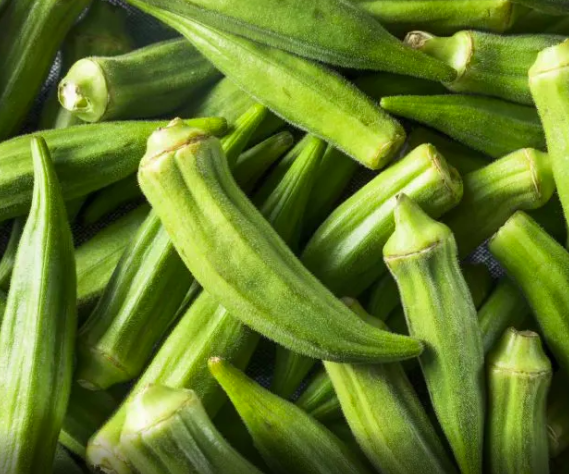
Anyone who’s ever opened a can of okra immediately wonders why they are adding this vegetable in the first place. In the North, fresh okra can be hard to find and the canned stuff is tasteless and slimy. And unless you know what you’re doing, even fresh okra can be turned into a mushy mess. So the only reason I dutifully cook gumbo with okra is that, well, it’s in all the best New Orleans gumbo recipes.
Why does it need to be in there?
You might say that if it doesn’t have okra, it ain’t gumbo. For one thing, that odd little pod is what gives gumbo its name. The African slaves who came to the American South grew the same vegetables they grew in West Africa: yams, black-eyed peas and okra mostly. The Bantu name for okra is ngombo. (Also guingombo, tchingombo, kingombo.) The French just call it gombo.
There are legends that slaves hid okra seeds in their hair and in their ears while aboard the galleons bound for the New World, but many historians make the argument that it was the Portuguese traders who imported the African vegetables into Brazil, along with the palm oil their slaves traditionally used to cook.
This makes sense on a couple of levels: (1) it seems unlikely that people being hunted and bound into slavery had the time and composure to plan out their gardens, and (2) it made good “business” sense for the Portuguese to keep their “property” healthy. All of these native African vegetables are what sustained the population for centuries. All of them supplied vital nutrients, especially in parts of Africa where other sources of nutrition was meager. Yams are a great source of betacarotene; black-eyed peas are an excellent source of calcium and Vitamin A. Okra is rich in potassium and antioxidants.
In short, gumbo is good for you, and it doesn’t have to be loaded with calories either. This recipe for shrimp and okra gumbo, for example, is just 300 calories per serving.
Yes, it is true that okra can lose its form and go all soft and mushy, but that’s another part of the reason the slaves used it in their stews. While the more European creole version relied on filé (raised by Native Americans) for their thickening agent, the West Africans traditionally make their soups and stews sturdier with okra.
Most of all, it’s one of the tastiest treats that New Orleans has to offer, and that is saying an awful lot. Here is the recipe for seafood gumbo that Poppy Tooker used to take down celebrity chef Bobby Flay in a New Orleans “Throwdown” episode. She has dozens of excellent New Orleans recipes in her cookbook, Crescent City Farmers Market.
Serves 10 to 12
• 1 cup oil
• 1 1/2 cups flour
• 4 gumbo crabs
• 4 lbs. shrimp
• 1 onion, chopped
• 1 bell pepper, chopped
• 3 stalks celery, chopped
• 2 lbs. okra, sliced 1/4 inch thick
• oil for frying okra
• 1 – 14.5 oz. can crushed tomatoes
• 1/2 gallon shrimp stock
• 1 clove garlic
• 2 tablespoons thyme
• 1 bay leaf
• 1 bunch green onions
Peel shrimp and combine peels, onion skins, and tops in a stock pot. Cover with water and boil for 10 minutes. Strain and reserve water.
Fry okra in very hot oil until lightly browned.
Make a dark roux with the flour and oil, cooking to the color of milk chocolate brown. Add onions, stirring together until the roux darkens to a bittersweet chocolate brown. Add celery and bell pepper. Sauté for five minutes, then add the gumbo crabs, tomatoes okra, herbs, and the shrimp stock. Add garlic and salt and pepper to taste. Simmer 45 minutes or longer. Ten minutes before serving, add shrimp and green onions. Serve on top of cooked rice.


 This year, students from the Badger State were treated to an especially memorable experience, when they took their tubas and trumpets onto the field of Raymond James stadium, alongside their heroes from the University of Wisconsin. The college band members, that is. The football team’s dramatic overtime 34-31 win over the Auburn Tigers was simply icing on the cake.
This year, students from the Badger State were treated to an especially memorable experience, when they took their tubas and trumpets onto the field of Raymond James stadium, alongside their heroes from the University of Wisconsin. The college band members, that is. The football team’s dramatic overtime 34-31 win over the Auburn Tigers was simply icing on the cake.



